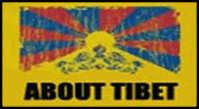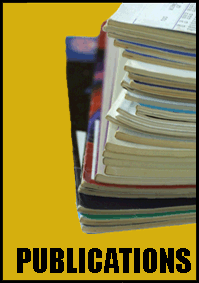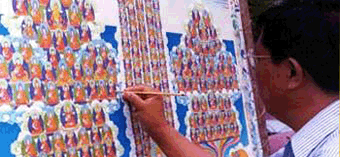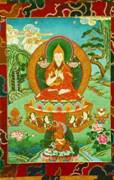

Tibetan art is deeply religious in nature, a form of sacred art. From the exquisitely detailed statues found in Gompas to wooden carvings to the intricate designs of the Thangka paintings, the over-riding influence of Tibetan Buddhism on culture and art can be found in almost every object and every aspect of daily life.
Tibetan art can be grouped into three parts:
Flat - Paintings which include 'Thangka painting', Murals (wall painting) Wooden Tablet and Sand Painting
Solid - 3-dimension - objects which include Bronze, Clay Sculpture, Clay Modeling, Wooden Carving, Stone Carving, Ritual Objects, Butter Sculpture, Mask and Cazha, and
Costumes - The thangkas are painted or embroidered images rendered on cloth, silk or paper which is mounted on a cloth backing and may be rolled up like a scroll when not hung.
a) Flat Painting
There are many schools of painting which may be classified as the Eastern Tibetan, the Middle Tibetan, the Western Tibetan. The Eastern Tibetan was the oldest and heavily influenced by those of the Han nationality. This style is individualistic and probably too free for the taste of Buddhists. The Western school began after the Indian master Atisa came to Tibet in the 11th century (Song Dynasty). Atisa brought Nepalese painters to work according to the rigid rules. The Middle Tibetan School is an integration of the above two.
Murals or Tibetan wall painting is an important part of Tibetan art. There are three types of murals in Tibet: religious, historical and social. Most murals focus primarily on religion. Although some early murals devoted to Bon still exist, most of the contemporary murals depict various aspects of Buddhism . The most popular murals are of religious figures , such as Buddhas, Bodhisattvas, Guardians of Buddhist Doctrines, Taras in the sutras, or Buddhist masters. The pigments used are similar to the one used for thangka painting. Wall paintings cover wider range of subjects than thangkas do. They include the images of Buddh a in his many manifestations, portraits of saints, great masters, founders of various Buddhist sects and the stories of their lives, wars, scenes of manual labour, construction of monastories and everyday life of the people. They are especially effective in creating a mystic atmosphere in the monasteries which will lead the viewers to believe that `this is where the Buddha resides'. Jokhang Temple and Tashilhunpo Monastery have built special courtyards dedicated to this type of mural painting
Wooden Tablet Painting represents yet another branch of Tibetan art. Its subjects and pictorial composition are similar to those of thangka and the difference is that the pictures are drawn on wooden tablets of various shapes. Some of them have handles attached to them for holding and hanging.
The materials for Sand Painting are coloured sand and minerals. They are filled inside a cone with a tiny hole at the tip. Many disperses though the hole will form a single line in the picture. The subject is usually `mandala'. Sand Mandalas Sand Mandalas are a Tibetan Buddhist tradition which represents how everything in life changes. A lot of time is given to make Mandalas. Once a Mandalas is made, they have a ceremony and then they destroy it. It shows that nothing lasts forever. First the monks sketch out the pattern, and th
en they fill the pattern with colored sand. In the old days, mon ks would use crushed colored stone, but now they usually use dyed sand. A team of many monks will work together on a mandala project, and it will take several weeks to build. The sand mandala is d estroyed in a specific way and in a specific order. Then the grains of sand are collected into jars that are wrapped in silk and then they bring it to a river to be put back into nature. The sand is never used again for another mandala. Below is a picture of a sand madala before it was destroyed.
b) Sculpture
As Buddhism believes in the worship of idols (as against a teachin g of Buddha), the production of the images of Buddhas and other deities must follow the strict rules prescribed in the cannon for their faces, gestures, the ornaments they wear and the objects they hold. The Tibetan artists absorbed the influences of the art of Han, Nepalese and Indian sculpture and developed a style and craft of their own which was distinctively Tibetan. The shaping of a bronze is a complicated process. It is so difficult and time-consuming that sometimes many artists spent all their lives making them but did not live to see them completed.
There are numerous Clay sculptures preserved to the present day. Most of them are sculptures of Buddhas, saints and great figures. Some of them are with treasures preserved inside. Clay modeling of miniature Buddhist image, called `phyag-tsha' or `tsha-tsha' in Tibetan, represents a form of artistic expression in Tibetan Buddhism. As the modelings are not difficult to make and the material is easily obtainable, such objects of art are turned out in large quantities by Tibetan. They can be found almost everywhere.
These beautiful engravings lavishly decorate the columns, beams, door, windows and cross-beam supports in Tibetan monasteries and temples. Shrines, platforms seating deities, altars, stupas and some ritual objects are often adorned with wood carving or stone carving.
Most Butter Sculptures produced in Lhasa and elsewhere are made for the Lamp Festival on the fifteenth day of the first month of the Tibetan year. The butter is first mixed with ice water, then mineral dyes mixed in. Working on a wooden support, a world of flowers and grass and towers and buildings, populated with men and animals and deities, is then created.
Masks depict the range of beings from deities to men and animals, qiangmu religious dances and folk tales. Those depicting humans are carved to display a certain characteristic such as honesty, harshness, greed or humor. Animals depicted are mainly deer, yaks, sheep and birds.
"Cazha" is an ancient traditional form of sculpture creating mainly the statues of Buddhas and Bodhisattvas. Engraved on the back of the wall are scriptures of prayers for good luck and prosperity. The wall is an object of various size, the wall, therefore, is called "Thousand-Buddha wall".
c) Costumed painting
A thangka composed of strung pearls is kept in Dradrug Monastery in Shannan. Thangka is a special art of Tibet. The material used for thangka is linen cloth or coarse woolen fabric or silk or paper. The cloth needs to be prepared first and then the artist works out the sketches of the portraits with charcoal sticks. The drawing usually begins at the center. Colouring comes last. The pigments used come from non-transparent minerals and plants such as malachite and cinnabar. They are mixed with animal glue and ox bile to make the lustre stay.
Websites related to the Tibetan arts










Web designed and developed by: Tenzin Sherab (Longsho leader) with funding from National Endownment for Democracy (NED)

